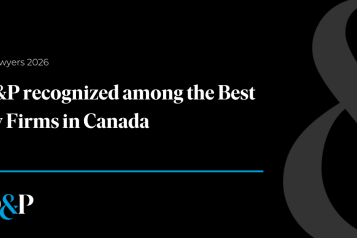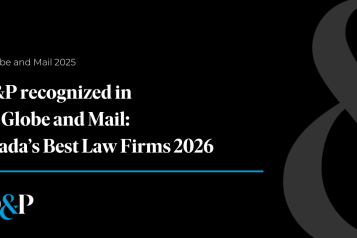Publication
Distress preferred shares are an option for borrowers to avoid insolvency or bankruptcy
Published March 24, 2020
The “distress preferred share” (DPS) provisions in the Income Tax Act (Canada) (the Tax Act) present an opportunity to reduce financing costs for a borrower. At the same time, a DPS restructuring can give the lender equal or better after-tax income on its investment, without sacrificing its security and priority. In the current economic climate, DPS may be an option for clients that want to reduce borrowing costs by restructuring their debt.
Benefit to the Lender
Of course, lenders will need to get on board. Essentially, a lender will be agreeing to swap its debt for preferred shares that pay a lower return. Why would they agree to do this? For several reasons:
- the after-tax, economic result of receiving DPS dividends can be equal to that of interest payments on debt;
- since the DPS dividend payment will be lower than the interest payment, this provides some relief to the borrower;
- the lender can maintain its security interest in the borrower's assets.
Dividends on DPS are effectively tax-free for the lender. The following example illustrates how the economics of DPS dividends versus interest payments works:
- A lender who receives interest at a rate of 6%, and pays income tax at a 25% rate, will have a 4.5% after-tax return.
- The lender would obtain the same after-tax return if it received a 4.5% dividend on a DPS instead of interest.
- The borrower, in turn, can free up cash flow by reducing its payments from 6% to 4.5%. In effect, any dividend rate higher than the lender’s after-tax return on interest at a given rate, but lower than that interest rate (e.g., between 4.5% and 6%) will leave both the lender and the borrower better off.
Normally, it does not pay for a lender to convert a loan into preferred shares. The shares will typically carry a fixed dividend and a fixed retraction price, and thus will be “taxable preferred shares” and “term preferred shares” under the Tax Act. Dividends received on these shares are normally subject to special taxes. However, the special taxes do not apply to DPS shares.
These special benefits for distress preferred shares are temporary: they apply for five years from the date of issue of the shares.
What are DPS
The definition of "distress preferred share" is complex. In general terms the distress preferred share must be a preferred share, or otherwise have debt-like characteristics, and be issued:
- as part of a proposal to, or an arrangement with, its creditors that has been approved by a court under the Bankruptcy and Insolvency Act,
- at a time when all or substantially all of its assets are under the control of a receiver, receiver-manager, sequestrator or trustee in bankruptcy, or
- at a time when, by reason of financial difficulty, the borrower (or another corporation resident in Canada with which it does not deal at arm's length) was in default, or could reasonably be expected to default, on a debt obligation held by an arm's length lender AND the DPS are issued in exchange or substitution for the debt.
In all cases, the proceeds from the issue of the share must be used by the issuer or a non-arm’s length corporation to finance a business that was carried on in Canada immediately before the share was issued.
When a distressed debtor is not in receivership or bankruptcy proceedings, it will have to satisfy the "financial difficulty" leg in part (iii) of this definition. Historically, in these cases, lenders have required a ruling from Canada Revenue Agency before they are prepared to convert their loan into a lower-yielding preferred share. We do not know yet whether this will continue to be true given the severity of the current economic climate.
How to structure DPS
In order to ensure that the lender retains security over the borrower's assets (as opposed to simply becoming an equity-holder), the CRA has approved variations of the structure as described below. The issuer of DPS is not the corporation that is in financial difficulty (i.e. the Original Borrower), but a single-purpose wholly owned subsidiary (New SPV).
New SPV's share capital consists of common shares, and non-voting preferred shares that will be the DPS. The DPS terms include a periodic dividend at a fixed rate, and have retraction rights in the event of default. Additionally, the shares have a mandatory redemption one month prior to their 5th anniversary.
New SPV advances the proceeds from the preferred shares to its parent corporation, the Original Borrower as an interest-free loan (the New Loan). The New Loan is secured by a charge on the assets of the Original Borrower. The Original Borrower uses the proceeds from the New Loan to repay the original loan.
Another method to get the same result is that New SPV uses the proceeds from the preferred shares to purchase the original loan from the lender, along with the accompanying security in the Original Borrower's assets.
The lender, the Original Borrower and New SPV enter into support arrangements whereby:
- the Original Borrower agrees to make capital contributions to New SPV to enable New SPV to pay dividends on the DPSs and all fees and expenses required to stay in good standing;
- the Original Borrower agrees to make principal payments to New SPV, including payments out of excess cash flow, so that New SPV will have the funds with which to redeem the DPSs;
- if New SPV purchased the original loan from the lender,
- the lender has a “call” option to buy back the loan and accompanying security (in effect allowing the lender to revert to its original position as a secured lender to the Original Borrower); and
- New SPV has a “put” option to require the lender to take back the loan after the lender has exercised its rights to retract the DPS for the then outstanding principal amount which New SPV will use to redeem the DPS (so that New SPV can meet the corporate law solvency test of having realizable asset value at least equal to the stated capital of the DPSs); and
- the Original Borrower and New SPV guarantee each other’s obligations to the lender.
The Canada Revenue Agency has provided many rulings on this type of structure.







